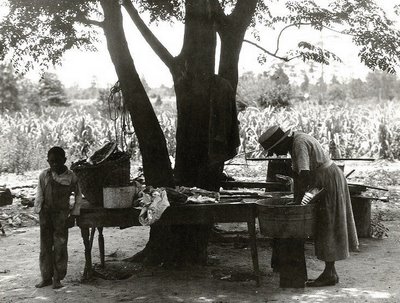
Influences of poverty on African-American gardens
 Perhaps
the most important factor influencing
African-American
gardens in the rural South --- and the hardest to
disentangle from other potential factors --- is poverty. If you
were born black in America, you are nearly three times as likely to
live in poverty as if you were born white. Many of the "unique"
aspects of African-American gardens are ones I grew up with in my own
area, since Appalachia is nearly as poor as the so-called "Black Belt"
further south.
Perhaps
the most important factor influencing
African-American
gardens in the rural South --- and the hardest to
disentangle from other potential factors --- is poverty. If you
were born black in America, you are nearly three times as likely to
live in poverty as if you were born white. Many of the "unique"
aspects of African-American gardens are ones I grew up with in my own
area, since Appalachia is nearly as poor as the so-called "Black Belt"
further south.
 Poor people tend to have smaller houses,
so it's no surprise that their
yards act as an extension of their living space. Even though most
of the families in Westacott's study now have electricity and running
water, many continued to use the back porch and/or the area around
their well as a center of cooking and washing. Anyone who has
cooked in the South in the summer without air-conditioning can
understand why you might want to can, make soap, or even fry up your
dinner outside over a fire rather than heating up the whole
house. And if you've been crammed into five hundred square feet
with five other human beings, you might choose to shell the peas
outside under a shade tree too.
Poor people tend to have smaller houses,
so it's no surprise that their
yards act as an extension of their living space. Even though most
of the families in Westacott's study now have electricity and running
water, many continued to use the back porch and/or the area around
their well as a center of cooking and washing. Anyone who has
cooked in the South in the summer without air-conditioning can
understand why you might want to can, make soap, or even fry up your
dinner outside over a fire rather than heating up the whole
house. And if you've been crammed into five hundred square feet
with five other human beings, you might choose to shell the peas
outside under a shade tree too.
Westacott noted that
"piles of temporarily discarded or
recently-acquired-for-some-unspecified-use-in-the-future materials are
commonplace on most small farms and rural properties." See, that
trash heap by our barn is just a sign of frugal ingenuity! The
author explained that similar piles grace most of the properties he
visited, for use in building animal pens and fixing other objects
around the farm. The families he visited even used found art to
brighten up their front yards, lining their paths with colored bottles
and tacking hubcaps to the fence.
| This post is part of our African-American Gardens and Yards in the
Rural South lunchtime series.
Read all of the entries: |
Want more in-depth information? Browse through our books.
Or explore more posts by date or by subject.
About us: Anna Hess and Mark Hamilton spent over a decade living self-sufficiently in the mountains of Virginia before moving north to start over from scratch in the foothills of Ohio. They've experimented with permaculture, no-till gardening, trailersteading, home-based microbusinesses and much more, writing about their adventures in both blogs and books.
Want to be notified when new comments are posted on this page? Click on the RSS button after you add a comment to subscribe to the comment feed, or simply check the box beside "email replies to me" while writing your comment.

We certainly have a bit trash heap, and I'm glad someone understands it. Every time my mom comes over, she looks at it, horror-stricken. But the truth is that Mark takes bits and pieces out of all that junk machinery all the time.
I like your point about the melding of cultures too.
I think that most family farms have some sort of junk heap stashed somewhere, because you never know when you might need that odd-shaped bit of metal or that tail end of the chicken wire or that left-over bit of tin-roofing. Personally, I think it's a great plan (although I am enough of a neatnik to try to keep our pile hidden, heh), because it both saves money and keeps stuff out of the landfill; that's one of the three "r"s of environmentalism, right? "Re-use?"
Anyway, I've been very much enjoying your various lunchtime "lectures" on different types of gardens around the world! My favorites were about cottage gardens (since that tends to be the way my own garden leans), but I've gotten lots of ideas to try and just interesting information from the others - thank you!